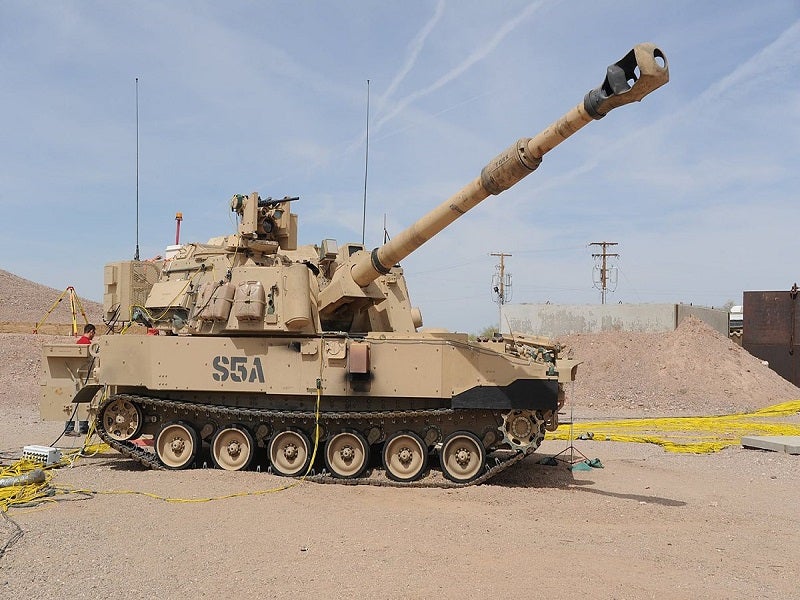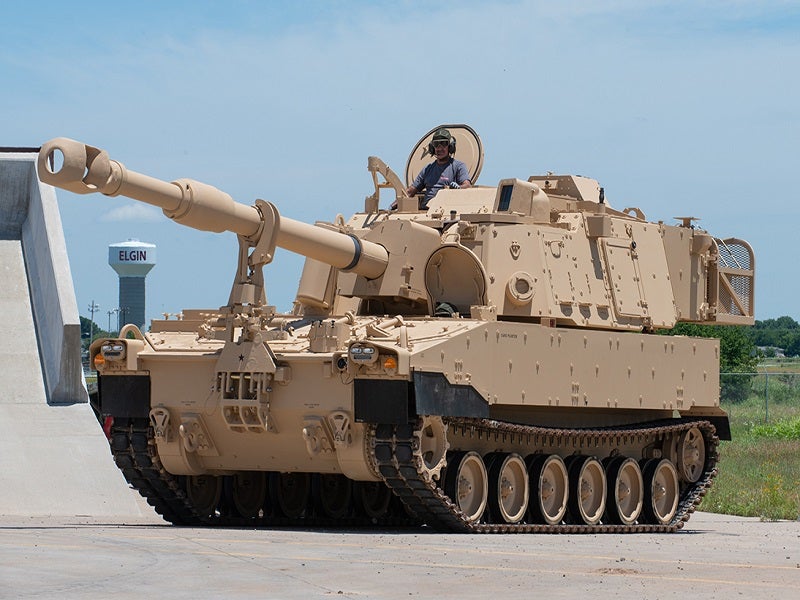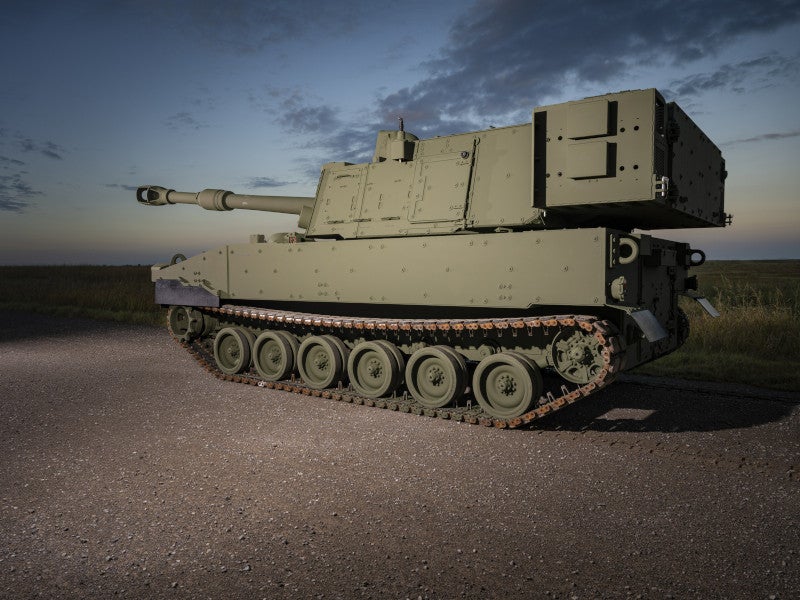The Paladin M109A7 next-generation artillery system manufactured by BAE Systems is a significant upgrade to the combat-proven M109A6 Paladin cannon artillery system.
The enhanced artillery system offers key fire support for various potential combat missions conducted by the US Army’s Armored Brigade Combat Teams (ABCTs) in conventional, hybrid, irregular and counterinsurgency combat environments.
The vehicle boasts enhancements in dimensions, weight, power, cooling efficiency, readiness, defensive measures, and overall battlefield survivability. It is designed to accommodate larger-calibre, extended-range cannon assemblies to meet the US Army’s objectives for increased range and lethality.
In March 2024, BAE Systems secured a contract worth up to $318m from the US Army to provide technical and sustainment support services for its M109A6 and M109A7 howitzers, as well as the associated M992A3 carrier, ammunition, tracked (CAT) vehicles.
BAE Systems will provide continuous engineering and logistics services, encompassing the delivery of new capabilities, maintenance, and testing for the M109 vehicle family, under the five-year contract.
Development of the M109A7 artillery system
The US Army and BAE Systems signed a memorandum of understanding for the Paladin integrated management (PIM) programme to upgrade the M109A6 Paladin self-propelled howitzer and its associated M992A2 field artillery ammunition support vehicle. The authority intends to procure 580 sets of PIM vehicles, which are expected to sustain until 2050.
The PIM modernisation effort was launched in 2007 and was followed by the award of a $63.9m research and development contract to BAE Systems for the production of five M109A7 howitzers and two M992A3 CAT vehicles in August 2009. The seven PIM prototypes were delivered in May 2011.
BAE Systems was awarded a $313m contract modification by the US Army in January 2012 to provide additional support for the engineering, manufacturing and development phase of the PIM programme. The US Department of Defence granted Milestone C approval for the PIM programme in October 2013.
M109A7 artillery system design and features
The PIM modernisation programme includes upgrades to hull, turret, engine, and suspension systems to offer increased reliability, survivability and performance over the M109A6 artillery system. The upgraded system is capable of providing consistent fire support in all weather conditions. The PIM cannon is mounted on the chassis structure common to the Bradley tracked fighting vehicle.
The vehicle is controlled by a crew of four and has an overall length of 9.7m, width of 3.9m, height of 3.3m and maximum gross weight of 35,380kg. It features digital backbone architecture and incorporates an onboard digital fire control system to provide fire mission and compute firing data to the M109A7 cannon system. It also consists of a position navigation system and a computer with comprehensive diagnostics programmes.
The new artillery system can select and take up firing positions, and automatically unlock and point its cannon while on the move. The modernisation effort also represents upgrades to space, weight and power-cooling (SWaP-C).
Paladin PIM armament
The Paladin M109A7 artillery system is armed with a 155mm M284 cannon with an M182A1 gun mount and an automated loader. The 155mm artillery system can fire at a sustained rate of one round a minute whereas the maximum rate of fire is four rounds a minute. The system has a range of 22km with standard projectiles and 30km with rocket-assisted projectiles.
The Paladin self-propelled howitzer can also be equipped with fire precision munitions, including the Excalibur and the precision guidance kit.
Protection features of Paladin PIM
The self-propelled artillery system is equipped with shoot-and-scoot capabilities to offer protection for the crew against counter-battery fire. It is also fitted with an automatic fire-extinguishing system (AFES), gunner protection kit (GPK) and enhanced applied armour.
Propulsion and performance of the Paladin M109A7
The Paladin M109A7 vehicle is powered by a 675hp engine. The propulsion system also consists of electric elevation and traverse drives, an electric rammer, an L3 HMPT-800 automatic transmission, and an onboard power system with a generating capacity of 70kW at a rate of 600V DC/28V DC.
The vehicle has a fuel storage capacity of 549l and a ground clearance of 0.4m. It can ford at a maximum depth of 1.07m and cross trenches with depths of 1.8m. The gradient and side slopes of the vehicle are 60% and 40% respectively, while the on-road speed is 61km/h and the cruising range is 300km.
Upgrades of the Paladin M109A7
The US Army and BAE Systems are working on increasing the combat capabilities of the M109A7 howitzer.
Improved capabilities are being developed under the US Army’s Extended Range Cannon Artillery (ERCA) programme, which is focused on developing a self-propelled howitzer with increased range and rate of fire. The M109A7 chassis will serve as the base platform for the new improved XM1299 self-propelled ERCA howitzer.
BAE Systems received a $45m contract for the ERCA Increment 1 prototype in July 2019. The enhancements developed under the ERCA programme are proposed to be integrated into the existing and future M109A7 howitzers to enhance their range and rate of fire.
The planned upgrade includes replacing the M109A7 howitzer’s existing 39-calibre turret with a 58-calibre, 30ft-long gun barrel to increase the range to more than 70km.
The ERCA fired three GPS-guided Excalibur projectiles during a demonstration at Yuma Proving Ground, Arizona, in October 2021. The US Army also conducted three autoloader tests between 2019 and 2021. An autoloader is used to automatically load the projectile and charge it into the cannon’s tube.
In October 2023, BAE Systems in collaboration with the US Army’s combat capabilities development command armaments centre (DEVCOM AC), achieved a record by firing the XM1155-SC guided projectile from an M109 Paladin over the longest distance to date for a guided projectile.
The projectile was accurately guided to its target using GPS technology, showcasing the enhanced capability it can provide to the existing howitzer fleet of the US Army.
The US Army cancelled the ERCA programme in March 2024 due to engineering challenges.
Orders and deliveries
The US Army awarded a $688m contract to BAE Systems in October 2013 for the production of Paladin M109A7 artillery systems, with an option to procure a total of 66 vehicle sets, including a self-propelled howitzer and an ammunition resupply vehicle. The artillery system was inducted into LRIP in May 2014.
An initial $195m contract included up to 18 vehicle sets, including M109A7 howitzers and M992A3 carrier ammunition-tracked vehicles. The first vehicle was delivered to the US Army in April 2015.
BAE Systems received a $245.3m contract from the US Army to conclude the LRIP of the M109A7 Paladin self-propelled howitzers and M992A3 ammunition carriers, in October 2015. The contract exercised the second option year to deliver 30 additional vehicle sets.
BAE Systems was awarded a $413.7m contract to complete the LRIP phase and begin the full rate of production of the M109A7 howitzers, in December 2017.
The FRP was delayed due to production quality and capacity issues found at the company’s manufacturing plant in York, Pennsylvania, US.
The US Army placed a contract modification order worth $249m to deliver 60 additional M109A7 howitzers along with M992A3 vehicles in December 2019.
The company received approval from the US Army to begin the FRP in February 2020.
A $339m contract modification to manufacture 48 vehicle sets of M109A7 howitzers and M992A3 CAT vehicles was awarded in March 2020. The contractual scope also includes support services and spare parts.
BAE Systems completed the delivery of the 300th vehicle set of the M109A7 artillery system in 2021. It delivered 133 low-rate initial production (LRIP) vehicle sets and 216 full-rate production (FRP) vehicle sets, by the end of June 2022.
The US Army awarded a $97.28m contract modification (P00098) to deliver additional M109A7 and M992A3 vehicles in January 2022.
It ordered 40 additional sets of M109A7 howitzers and the accompanying M992A3 ammunition carriers under a contract worth $299m in July 2022. BAE Systems is also required to provide spare parts, as part of the contract.
In November 2023, BAE Systems secured a $418m contract from the US Army for the production and supply of additional M109A7 self-propelled howitzers. Deliveries are expected to occur through 2025.






